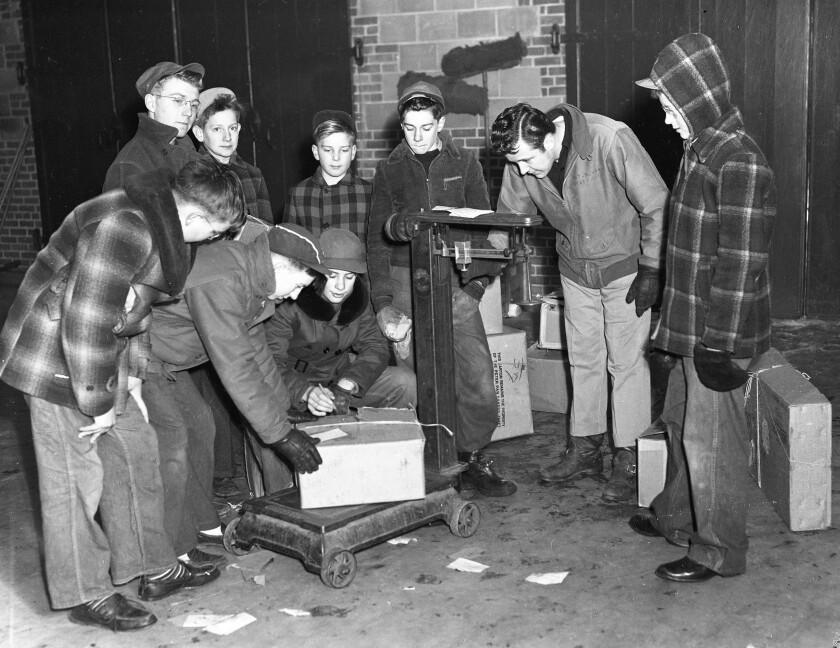WORTHINGTON — During his 19 years in Worthington, George Draper Dayton revealed the dynamic qualities that would later distinguish him as the founder of Minnesota’s largest department store complex. Dayton recognized Worthington's potential and worked diligently to establish a thriving agricultural community here.
Backed by eastern investors, the 26-year-old Dayton trekked to Worthington in 1883 to take control of the Worthington Bank. Days before he arrived, Dayton learned the banking business in a few nights’ coaching from George S. Price, later treasurer of the New York Central Railroad. He set up business on Worthington’s 10th Street and soon became an influential member of the community.
Dayton prospered as owner and president of the Worthington Bank and later organized the Minnesota Loan and Investment Company. He served 12 years on the local board of education and proved a valuable member of Westminster Presbyterian church. He accepted the responsibility of Sunday School Superintendent and chairman of the building committee.
The Dayton family lived in the large house on the corner of Fourth Avenue and 13th Street, which is presently part of Cashel’s Boarding Home. The house featured New England design with twin chimneys, widow’s walk, iconic pillars and an immense porch surrounded by spacious lawn. Here the Dayton boys, Draper and Nelson, who would expand the business empire their father founded, grew up.
1/28: People enjoy splashing in Lake Okabena in this undated image from the Nobles County Historical Society archives.
Nobles County Historical Society
2/28: Activity abounds in the early days on Worthington's Lake Okabena.
Nobles County Historical Society
3/28: Fourth generation farmers Norm Larson (left) and John Moberg stand at the site where a sod hut, shared by their forefathers, was located in rural Worthington.
File photo
4/28: An Independence Day celebration takes place on the yet-unpaved 10th Street in downtown Worthington.
Nobles County Historical Society
5/28: Paycheck and Ruby Begonia race team members get ready to chase their birds down 10th Street in one of the early days of the Great Gobbler Gallop.
File photo
6/28: Crowds gather to watch the Great Gobbler Gallop down 10th street in downtown Worthington.
File photo
7/28: Peter Hartwich, of Excelsior, Minnesota sails on Lake Okabena between races during the 2022 Worthington Windsurfing Regatta.
Tim Middagh / The Globe
8/28: Windsurfers race during the 2022 Windsurfing Regatta on Worthington's Lake Okabena.
Tim Middagh / The Globe
9/28: Crowds gather to hear musical acts during the 2022 Windsurfing Regatta and Music Festival on the shores of Lake Okabena.
Tim Middagh / The Globe
10/28: The Thompson Hotel is seen in this undated photo of Worthington's 10th Street.
Nobles County Historical Society
11/28: The Thompson Hotel recently underwent a major renovation of its apartment units and 10th Street storefronts.
Tim Middagh / The Globe
12/28: Jack Boote, with a cigar in his mouth, holds a couple of boxes of turkey poults that are being loaded into his plane for delivery.
Nobles County Historical Society
13/28: Worthington's Jack Boote poses for a photo in a private rail car in this undated image.
Nobles County Historical Society
14/28: E.O. and Bella Olson
Nobles County Historical Society
15/28: The home of George Draper Dayton and his family for the 19 years they lived in Worthington remains today at the corner of 13th Street and Fourth Avenue. The Dayton House is now a bed and breakfast and a community gathering space.
Nobles County Historical Society
16/28: Teams of horses are used to assist with ice harvest on the shore of Lake Okabena.
Nobles County Historical Society
17/28: Crews push ice chunks toward the conveyor belt as they harvest ice from Worthington's Lake Okabena.
Henry Blume
18/28: Crews harvest ice from Lake Okabena in this undated file from the Nobles County Historical Society.
19/28: An undated street scene of downtown Worthington.
Nobles County Historical Society
20/28: The Chinese ceremonial Lion Dance group works the crowd at the 28th annual Worthington International Festival Saturday afternoon, July 9, 2022.
Tim Middagh / The Globe
21/28: The flag bearer for Mexico gets the flag ready for the parade of flags at the opening of the 28th annual Worthington International Festival July 8, 2022.
Tim Middagh / The Globe
22/28: Much of Crailsheim was destroyed by bombings shortly before the end of World War II.
Nobles County Historical Society
23/28: The people of Crailsheim gather to get supplies sent over in a shipment from Worthington residents.
Nobles County Historical Society
24/28: Volunteers sort through the many items donated by Worthington residents to be shipped to the people of Crailsheim, Germany.
Nobles County Historical Society
25/28: Volunteers weigh boxes of items ready to be shipped to Crailsheim, Germany.
Nobles County Historical Society
26/28: Martha Cashel (with letter) initially sought to help her Finnish pen pal by gathering shoes to send to Finland. Her idea prompted her parents to provide aid to war-ravaged Europe on a grander scale, and that's what led to the sister city partnership with Crailsheim, Germany.
Nobles County Historical Society
27/28: An early day gathering at Worthington's Chautauqua Park.
Nobles County Historical Society
28/28: The Little Sioux steam boat takes passengers for a ride on Lake Okabena.
Henry Blume
As a citizen and banker, Dayton worked to attract settlers to the area. At times he virtually drafted men to agricultural duty. One discouraged citizen who gave up his property to work in town was prodded back to the country with land Dayton sold him at $8 an acre. Dayton threw in 19 cows plus enough capital to make a fresh start. He also recruited one of the city’s infamous drunks and set him up on what became a remarkably prosperous farm.
Dayton was perhaps the most influential person in changing the local agricultural landscape. During his Worthington years he broke the farmers’ stubborn prejudice for wheat, and corn became the chief crop. He convinced clients that hogs would pay off the mortgage quicker than anything else, thus stimulating livestock production. Because Dayton missed the New England fruit orchard, he offered to pay the cost of the original plantings for anyone interested in such an experiment. Soon apple orchards flourished on local farms.
Worhtington survived the panic of 1893 due to Dayton’s faith in the recuperative power of the agricultural community and his own determined will to survive. The Worthington Bank remained open during the initial run. Dayton reassured clients and met every demand. At one time he charged into the kitchen of a woman who had withdrawn all of her money and told her briskly that he needed the money worse than she did, so he took it.
At the end of the nation’s financial crisis, Dayton published an advertising leaflet whose cover read, “After a cyclone has swept over the country, the trees left standing are considered first-class timber.”
By the turn of the century, prosperity had returned to Worthington. Dayton prospered also and eventually expanded into activities that took him from Worthington to Minneapolis. In Minneapolis, he founded Dayton’s department store.












































